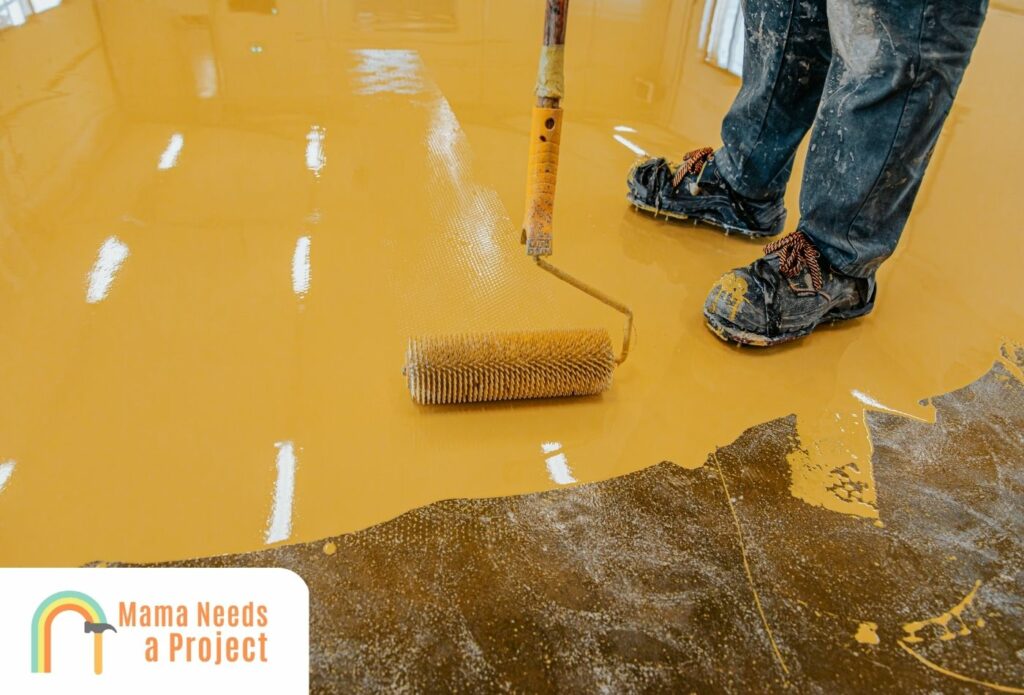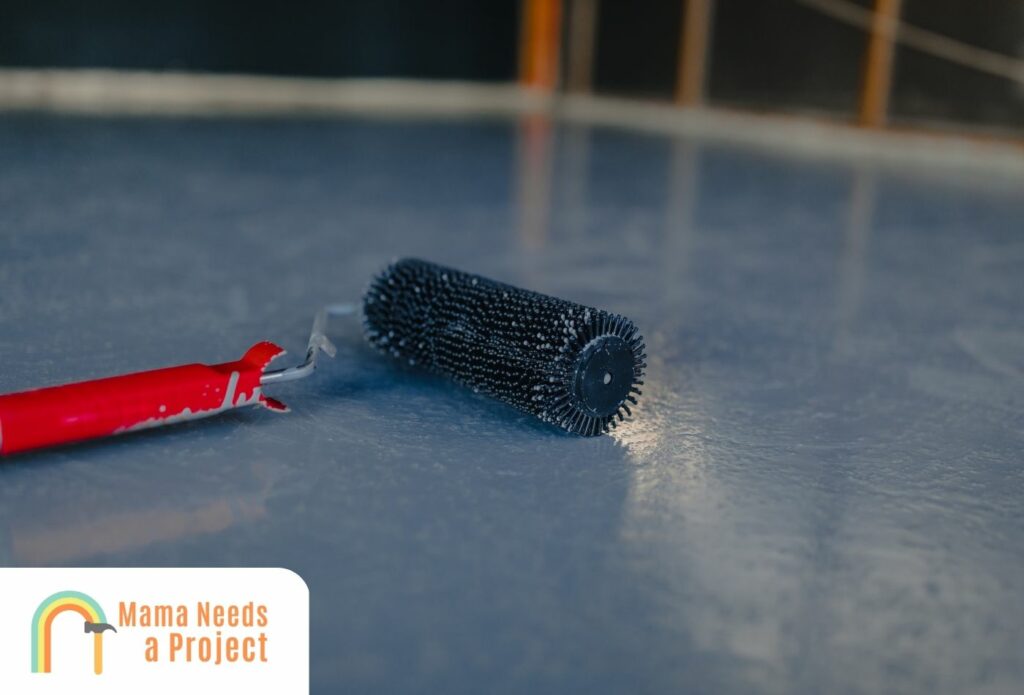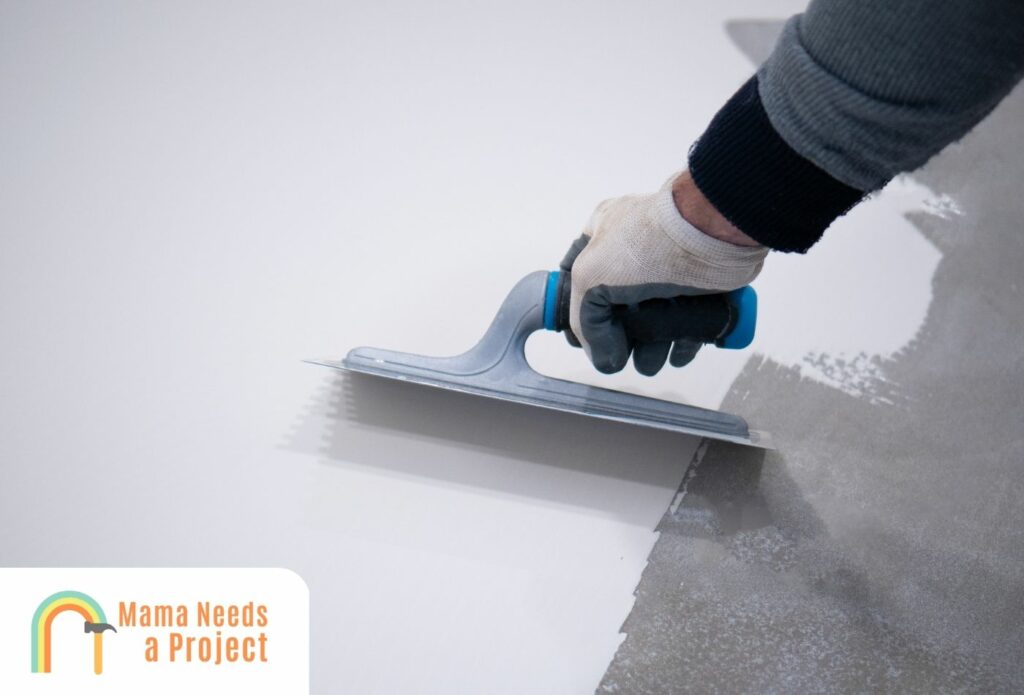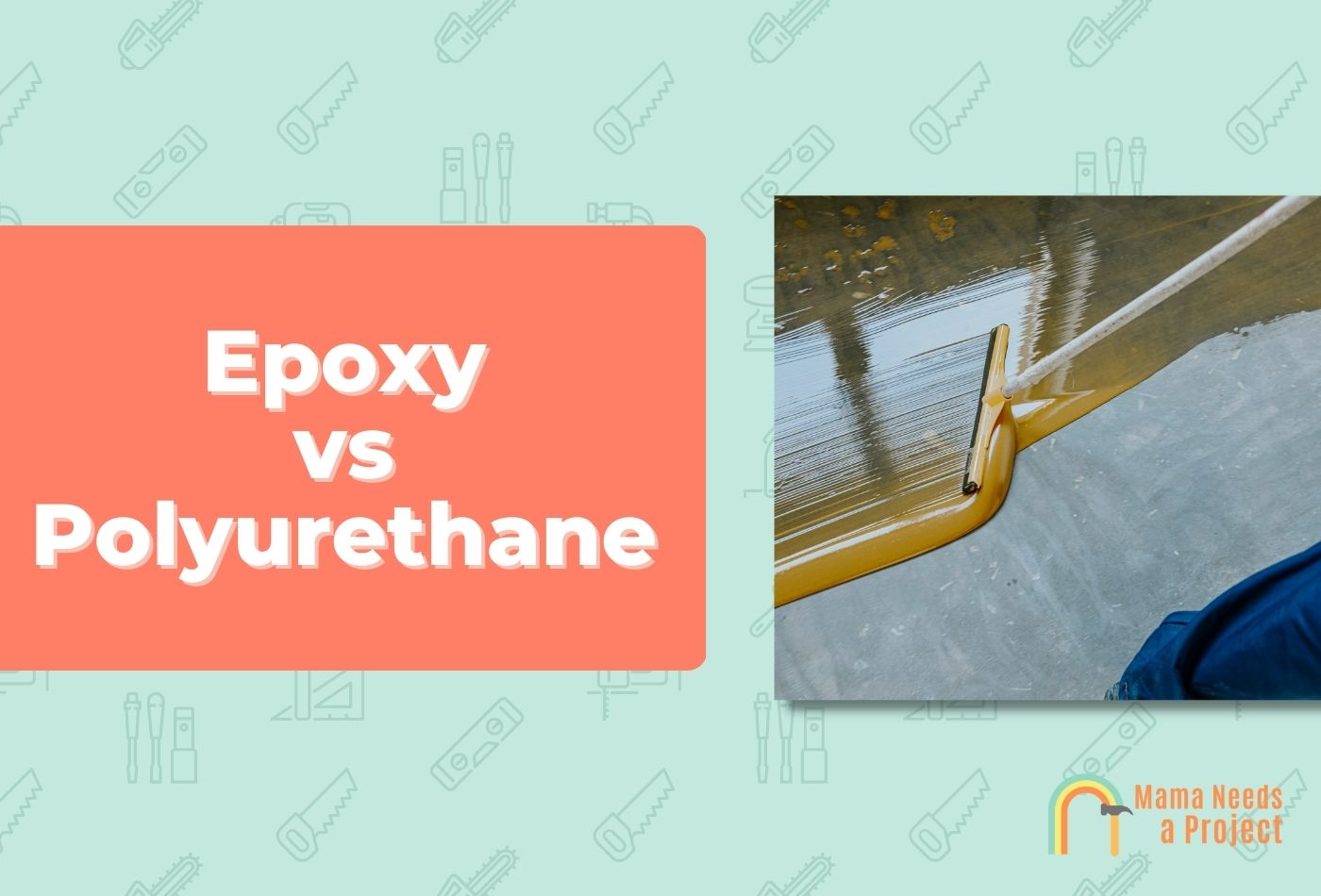Epoxy vs Polyurethane: Which is Better? (Ultimate Guide)
Wondering what the differences are between epoxy vs polyurethane and which one you should use?
In this post, I’ll break down the key differences you should be aware of when deciding which is better for your floors!
- Polyurethane is more durable, longer lasting, and more versatile than epoxy, but epoxy dries and cures faster, isn’t as toxic, and is easier to apply.
- Often, these finishes are used together to achieve maximum durability and superior appearance. In many cases an epoxy primer is used before an epoxy base coat, and then a topcoat of polyurethane is applied.
What is Epoxy?

Liquid epoxy is what you get when you mix epoxy resins with a hardening or curing agent. It’s used throughout numerous industries, including the construction, automotive, food packaging, and aerospace industries.
A few coatings of epoxy can strengthen concrete, wood, metal, and other materials, and epoxy also helps these materials resist corrosion.
Businesses that require sterile surfaces often use epoxy because it can withstand stronger cleaning products.
Epoxy Pros
Durable

Epoxy forms a durable, protective coating once completely cured, and its durability not only makes it impact-resistant but scratch- and corrosion-resistant as well.
In fact, its durability is the main reason why it has numerous commercial and industrial applications.
Epoxy is often applied to metal casings, concrete tiles, and hardwood floors.
It’s also used on composite pipes and tanks, as well as steel plumbing devices, because it can resist chlorine and microbes well.
Finally, epoxy’s durability makes it ideal for the many metal components used in cars, and because it’s lightweight it improves fuel efficiency, thereby making it eco-friendly too.
Flexible
Because it can withstand temperature fluctuations well, epoxy is widely regarded as a flexible, protective coating.
Its flexibility is a main reason why it’s used on concrete, as this material expands and contracts as a result of temperature fluctuations
Other protective coatings are rigid, meaning if they expand and contract frequently, they are going to crack.
Epoxy’s flexibility is important in food processing plants specifically, as here the temperature can go from low to high multiple times in a single day.
Faster Drying Time
Epoxy will become semi-dry in 7 to 10 hours, and it takes just seven days for it to be completely cured. Its drying and curing times are a lot quicker than other protective coatings.
Heat-Resistant
Epoxy’s ability to resist heat well is another reason why it’s a widely used protective coating.
Often, epoxy is applied to many metallic and wooden structural components to make structures more fire-resistant overall.
Epoxy can withstand temperatures up to 400°F, while super high-quality epoxies can withstand temperatures up to 600°F.
Corrosion-Resistant
Epoxy is also corrosion-resistant, and this quality is in part what makes it so sought-after.
Because it can resist rust well, it’s used on everything from car bodies to steel beams. And often it’s used outside, since it can withstand all kinds of weather.
Epoxy Cons
UV Rays Cause Yellowing
If epoxy is applied to a surface that’s frequently exposed to sunlight, it will start to yellow, eventually developing an amber film. This is because UV light discolors epoxy.
The same thing can happen with oil-based polyurethane but not with water-based, as the latter has better UV resistance.
What is Polyurethane?

Polyurethane is another protective coating that’s made of polymers and urethane.
The two main kinds of polyurethane are oil-based polyurethane and water-based polyurethane.
Oil based polyurethane is durable, long-lasting, resistant to a range of erosive of elements, affordable, and easy to apply.
It is, however, rife with volatile organic compounds (VOC), and it takes a long time to dry and cure.
Also, it can yellow over time, especially if it’s constantly expose to UV rays.
Water-based poly, on the other hand, is colorless, quick-drying, and contains less VOCs, but it isn’t as strong as its oil-based counterpart.
Polyurethane Pros
Durable
Polyurethane is a durable finish once completely cured. It offers superior abrasion resistance as well as heat-, moisture-, and chemical resistance.
Because of its durability, it’s widely used on both industrial and commercial floors. A concrete floor, in particular, can benefit immensely from being coated with polyurethane, as it makes this already durable material even stronger.
Oil-based polys are more durable than water-based versions largely because of the components they utilize.
Generally speaking, oil-based poly is a better outdoor finish than water-based poly.
Long-Lasting
If maintained well over the years, polyurethane can last a long time.
Maintaining a polyurethane finish isn’t hard, and if you do this often you can ensure the surface underneath the poly stays protected.
On average, polyurethane finishes last three to six years. But if you take especially good care of your finish, it could last longer than a decade.
How often a poly surface needs maintenance largely depends on the conditions it’s subjected to day in and day out. So polyurethane floors that are exposed to a lot of foot traffic need more maintenance than those that barely get tread on.
Cost-Effective
Since it’s a durable and long-lasting finish, polyurethane is cost-effective as well.
A gallon of polyurethane, which can be used on multiple surfaces, shouldn’t run you more than $70, and that’s for the really high-quality stuff.
Most polys are between $30 and $40.
The bottom line is this: if you can keep your polyurethane finish sound and strong over the years, you can avoid thousands of dollars in surface damage repairs, and all you would’ve spent was ~$50 on the protective poly.
Versatile
Polyurethane is one of the most versatile floor coatings out there, as it can be used on both residential and industrial floors.
The main reason why it’s used on industrial floors is because it resists many of the elements that wear floors down, like dirt, foot traffic, hot and cold tires, heat, chemicals, and moisture.
Other finishes can only be applied to wood and wood-based materials, but polyurethane can be used on concrete floors, wood floors, and everything in between.
Easy Application
Applying polyurethane isn’t hard. All you need is some sandpaper, polyurethane, mineral spirits, and a couple of dry cloths.
Basically, you sand before applying the polyurethane, and then you wait for the poly to dry. You repeat this simple process until you have the desired number of polyurethane coatings.
Polyurethane Cons
Toxicity
One of the biggest downsides of polyurethane is its high-level of VOCs.
Exposure to these compounds can adversely affect your health in numerous respects, and this is why you should stay clear of recently applied polyurethane for at least 72 hours.
A polyurethane coating is most toxic right after it’s applied, but the longer it’s left to cure the less toxic it’ll be.
Differences Between Epoxy and Polyurethane
Durability
Polyurethane is more durable than epoxy, but that doesn’t mean epoxy is a weak finish—far from it.
Where polyurethane has epoxy beat is in the chemical resistance category; epoxy doesn’t resist chemicals and organic acids as well. This is a main reason why polyurethane is essential to the food processing industry.
But when it comes to heat resistance, epoxy can withstand up to 400°F, whereas polyurethane can only withstand 200°F.
The reason why polyurethane is stronger than epoxy is because polyurethane has a higher cross-link density.
Drying Time
Epoxy becomes semi-dry quicker than oil-based poly, but it doesn’t dry faster than water-based poly. Water-based poly becomes semi dry in an hour, whereas oil-based poly and epoxy become semi-dry in about seven hours.
Epoxy does, however, cure faster than both oil-based and water-based poly, taking just seven days to cure; water-based poly takes 14 days while oil-based takes 30 days.
Drying time is also relevant when considering toxicity. Specifically, if a finish takes longer to dry, it’ll emit toxic fumes for longer. This is more the case with polyurethane than it is with epoxy.
Appearance
Epoxy and polyurethane finishes look similar.
However, if epoxy is exposed to UV rays for a prolonged period, it’ll start to turn an amber color. Polyurethane that’s oil-based will turn a similar color over time.
Water-based poly, on the other hand, is colorless, which is why it’s used on softwoods; the colors these woods feature usually don’t go well with the amber tint.
If you don’t apply epoxy or poly correctly, you could get a cloudy or blotchy finish.
UV & Water Resistance
Polyurethane is more UV-resistant than epoxy, but both are sufficiently water resistant.
Because polyurethane is an effective sealer, it’s often used on countertops, floors, and other surfaces that are frequently exposed to water.
Polyurethane is also applied to concrete flooring because water can wreak havoc on unprotected concrete over time.
When to Use Epoxy
Epoxy floor coatings can be found in factories, auto body shops, food processing plants, and many other places that utilize concrete floors.
An epoxy coating is not only heat-resistant but chemical-resistant as well, and both qualities are needed at manufacturing centers, warehouses, and hospitals.
Check out this guide if you need help getting epoxy off your hands or skin!
When to Use Polyurethane
Applying several polyurethane coatings will ensure a more durable surface, which is why polyurethane is applied to all kinds of materials.
Hardwood floors, a range of furnishings, metal structural components, and many fixtures can benefit from being coated with polyurethane, as it’s not only a top-notch sealant but visually appealing as well (when applied properly).
Final Thoughts
In most respects, polyurethane is superior to epoxy resin. It’s more durable, versatile, and lasts longer. But epoxy dries faster and is less toxic.
The truth is, both finishes will hold up well and look good for many years, and neither is too expensive. It’s just that polyurethane coatings are slightly better than epoxy coatings.
But if you want an ultra durable finish, use epoxy primer, an epoxy base, and a polyurethane topcoat; this way you combine the best of what both finishes have to offer.

